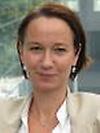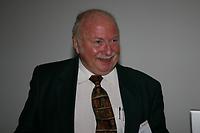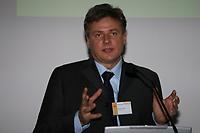Track 4: General, Part 1
#

Azuma Junichi: The Possibility of Implementing a Computer-Mediated Universal Symbolic Language- Hints from Sign Language and Graphic Emoticons
#
This research will discuss the possibility of implementing a computer-mediated universal symbolic language that will overcome the barrier of language difference, with special emphasis on word/symbol order and syntax. Temporal aspects of conventional sign languages will be also referred. It is argued that graphic or animated emoticons mainly used in today's Internet forums, blogs and instant messenger programs as well as in the mobile phone email systems of some Asian countries will grow into one of the candidate systems for the prototype of the future universal symbolic language. It is considered that such a future universal symbolic language will not only help us in the complicated multilingual situation but also aid the everyday communication of the aged and physically handicapped people.
About Junichi Azuma
Education:
1976 Bachelor of Arts (Kobe City University of Foreign Studies: 1972-1976)
1982 Master of Education (Hyogo University of Teacher Education:1980 -1982)
Work Experiences:
Teacher of English as a foreign language at Hyogo Prefecture senior high schools (1976-1988)
Lecturer of English as a foreign language at Kenmei Women’s College (1988-1991)
Associate Professor of English as a foreign language at Kenmei Women’s College (1991-1993)
Associate Professor of English as a foreign language at University of Marketing and Distribution Sciences (1993-1996)
Professor of English as a foreign language and Media & Communication Studies at University of Marketing and Distribution Sciences (1996-present)
Research Experiences:
Studies on interaction of speech rhythm and the rhythm of the speech-accompanying body movement and its effect on auditory comprehension of English as a foreign language, where parallelism between speech rhythm and the speaker's unintentional nodding movement was quantitatively analyzed. These studies also employed perceptual experiments where two homogeneous groups were exposed to the same listening materials of English as a foreign language, with one group listening to the materials in audio-only mode and the other group in audio plus visual (upper half of the speaker's body was shown: the bodily movements included no meaningful gestures) mode. The statistical analysis confirmed that the bi-modal (audio + visual) group achieved better results in comprehension of the listening materials than the audio only group. (1980-1983).
Analysis of multiple-choice tests for English as a foreign language based on the classical test theory, including item analysis employing point bi-serial correlation coefficient analysis (1984-1988).
Analysis of prosodic features marking the major syntactic boundary of Japanese - through perceptual experiments on interpretation of syntactically ambiguous Japanese sentences. Experiments employing PARCOR-synthesized speech stimuli showed that fundamental frequency, rather than a pause, is the primary prosodic cue to mark the syntactic boundary of standard Japanese. This research was part of a large-scale national project called "Japanese Prosody and its Education" (funded by the Ministry of Education and Science, official research period 1989-1993). (1989-1994).
Study on research method for quantitative analysis of prosodic features of Japanese (especially fundamental frequency). (1995-1997).
Study on usage of WWW for English teaching and analysis of educational process from the viewpoint of Knowledge Management (1997-2003).
Research on subject/discipline-specific metadata repository of learning resources on the Internet (2003 -present).
Chroust Gerhard: Dichotomic Architectural Alternatives in Software Design and their Historical Origins
#
Software-intensive systems increasingly exhibit the behaviour of "wicked systems" (using Hermann Kopetz’ terminology): they are large, complex, ill-defined, lack a clearly identifiable objective, have no precise termination rule; and there is always a still better solution. And they have the property that the problem cannot be specified without some concept of its solution.
With respect to their design this means that one has to make intuitively some a-priori archi- tectural decisions which cannot easily be reversed later. We call the basis for these decisions Di- chotomic Architectural Patterns because they usually have an ’either-or’-property and effect the basic architecture of the system to be designed (e.g. ’centralize or decentralized communication’). Starting with the wrong pattern not only will lengthen the development pro- cess; under today’s pressing time-to-market and cost demands, reversing and redirecting such a pattern in a project is not possible or at least not feasible. The consequence is that a project eit- her continues with an inappropriate basic architecture or the project is abandoned. A simplistic example of such a pattern is expressed in the popular saying "You can’t keep the cake and eat it".
We observe that most of these Dichotomic Architectural Patterns can theoretically be taken to their extremes. These extremes can be described and analysed, and their essential properties, implications, consequences, and interactions identified. For any realistic system there will be some trade-offs especially since the various choices interact with one another. These Dichotomic Architectural Patterns can be classified (not necessarily uniquely) into 5 dimensions
- Enactment Time (on-demand - pro-active)
- Location (local-remote)
- Granularity (coarse - fine)
- Control (central-distributed)
- HCI-cooperation (human-initiated/computer-initiated)
For each dimension we cite numerous examples from the architecture of software-intensive systems and discuss some of their properties. Looking into the past we recognize that many of these Dichotomic Architectural Patterns only came into existence due to some progress in hardware and/or software (e.g. in 1969 the ARPANET was created as a means to decentralization utilizing then available hardware and software achievements Plasser-05). It can be considered an important milestones in the deve- lopment of the Information and Communication Technologies. We will identify for most of the Dichotomic Architectural Patterns their origin in history and thus put a date on them, sometimes mentioning the emergence of the concept and its (sometimes much later) practical use. We believe that identifying, isolating and describing these patterns together with their essen- tial properties, implications, consequences and interactions, will help and guide system designer (both newcomers and seasoned ones) to judge available alternatives and their trade-offs. This would allow better initial architectural decisions and provide justification and support for such often intuitive decisions. To the older generation this paper will also help to reminding us of some of the (then) sensational milestones in informatics we have experienced in our professional life.
About Gerhard Chroust
His research interests are Representation and Enactment of Software Process Models, Quality and Improvement of Development Processes, Software Inspections, Software Engineering Environments, Information Engineering, Systems Science and Systemic Aspects of Engineering, History of Computers and Information Technology, Human Aspects of Software Development
He is Secretary/Treasurer at IFSR (International Federation of Systems Research), Vice-President of the Austrian Society of Cybernetic Studies, Advisor to Austrian Standards Committee, WG on Information Processing, Editor-in-Chief of IFSR Newsletter a.o. Furthermore he is Chairperson of the Editorial Board of the Book Series of the Austrian Computer Society (OCG), Editorial Board Member of numerous Journals (e.g. Journal of Systems Research and Behavioral Science, Computer Standards and Interfaces )
Prof. Chroust is a also an active member of many organizations (e.g. ACM, ACM SIGSOFT, IEEE, IEEE Computer Society, EUROMICRO, OCG) and holds many conference functions.
Koch Günter: Methods of identifying the knowledge of societies - and what it has to do with TU Graz
#
Knowledge Management has been a discipline which has undergone several cycles of pradigmatic changes in methods and tools, as well as in dimension from personal to organisational knowledge management, but always on a micro(economic) level. Since a few years, knowledge has become a concept of interest in macroeconomics: Intellectual capital & assets analysis has been expanded for profiling regions and nations. The paper gives a survey on current projects and momenti in legislation in this field which shall lead to a new quality of economic competition between nations.
In his capacity of being a member of "The New Club of Paris" the way of working of which compares to the ‘Club of Rome’, and as the Paris Club is devoted to support transformation processes from the information society to the knowledge society, the author would like to set a reference to his period of work when he was guest professor at Hermann Maurer’s institute in the early 90ies, as in this period he prepared the grounds of what today is called an "Intellectual Capital Report" (ICR). As a method, ICR (in German: "Wissensbilanz") has become one method which is imposed on Austria’s universities by means of Austria’s University Law and which can be understood as a very first step to identify the knowledge potential and change in knowledge of a university or any other knowledge generating organisation over time.
About Günter Koch
Professor Koch unites several and even divergent qualifications in his person: entrepreneur, manager and scientist. His last appointment as a manager was in 1998 as the CEO of the Austrian Research Centres (ARC), Seibersdorf, Austria’s largest research organisation employing some 1200 people in many different disciplines including material sciences, life sciences, information technologies, system research, medical technology, energy and environment etc. His first appointment in Austria was in the early 90ies, when he was invited to become a guest professor at the computer science faculty at Graz Technical University. From 1993 to 1997 he was the General Director of the European Software Institute (ESI) in Bilbao, Spain. After having been assistant professor at Karlsruhe University’s computer science faculty from on 1975, he became founder managing director of a systems company specialising first in medical informatics in 1981 and later in automation and in software technology. In co-operation with Prof. Ursula Schneider; Graz he created the currently most widely used reference model for Intellectual Capital Reporting, first time applied at the Austrian Research Centres in 1999.
Koch, currently lives in Vienna and acts as the president of the Austrian Association for research in IT, works (part time) as General Secretary of ‘The New Club of Paris’. He is member of the Board of the Fraunhofer Institute FIRST in Berlin, and he is affiliated with the Vienna- based Knowledge Management Associates / Academy / Association (KM-A) and its cooperation partner Execupery. He is an associate of the "Institute for Futures’ Futures", now called THE KENOS CIRCLE, founded by the Santa Fe Institute’s fellow John Casti in Vienna, specialising in foresight. He is an outspoken expert in defining and identifying intellectual assets in "brain organisations".
Fröhlich Bernd: Multi-Volume Rendering
#
We present a powerful framework for 3D-texture-based rendering of multiple arbitrarily intersecting volumetric datasets as they are common in the oil and gas industry or in the medical domain. Each volume is represented by a multi-resolution octree-based structure and we use out-of-core techniques to support extremely large volumes. Users define a set of convex polyhedral volume lenses, which may be associated with one or more volumetric datasets. The volumes or the lenses can be interactively moved around while the region inside each lens is rendered using interactively defined multi-volume shaders. Our current implementation uses slice-based volume rendering and allows interactive roaming through multiple intersecting multi-gigabyte volumes.About Bernd Fröhlich
Continue to Track 5



